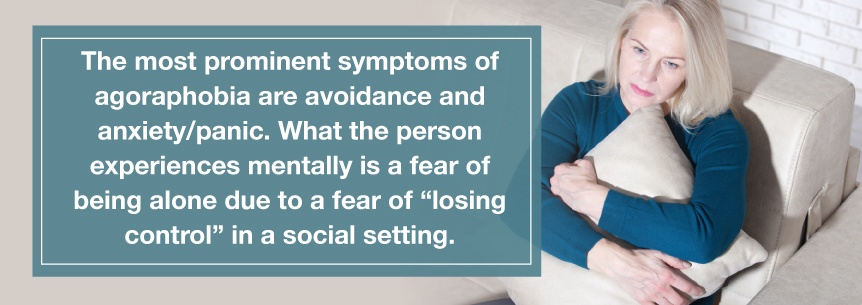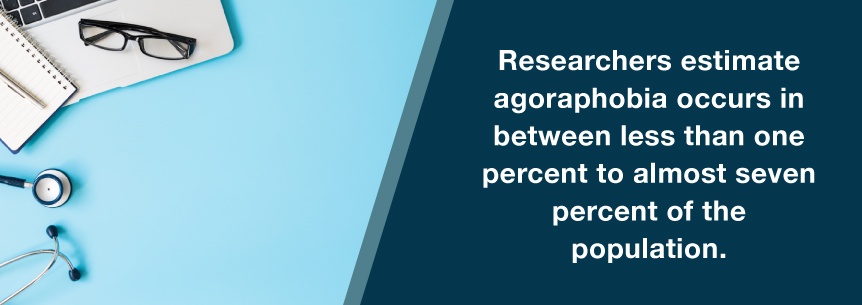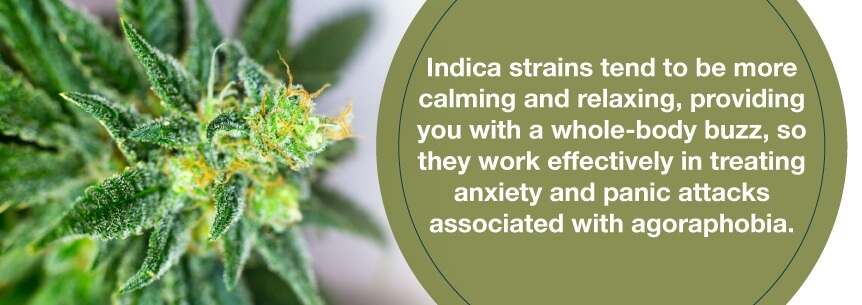If you’ve been struggling with anxiety and panic attacks that peak when it’s time for you to leave home to go about your daily tasks, you may have a condition known as agoraphobia. While prescription medications are standard for treating agoraphobia, medical researchers are finding that medical cannabis can be beneficial as a treatment complement or a natural alternative. Medical marijuana for agoraphobia shows a lot of promise.
Agoraphobia is a type of anxiety that triggers fear, avoidance, and panic in certain situations or places. Individuals with this disorder often feel trapped, embarrassed or helpless. The following types of settings are triggering to those with agoraphobia.
To be diagnosed with agoraphobia, you need to have intense anxiety or fear of two agoraphobic situations, such as those listed above. You also need to display avoidance-related behaviors.
It’s estimated that up to anywhere from 1 to 2 percent of adults in the U.S. have agoraphobia, according to the National Institute of Mental Health (NIMH), with women accounting for the majority of cases. Nearly 41 percent of agoraphobia cases are thought to be severe. Severe agoraphobia can be extremely disabling.
It’s common for those who experience severe panic attacks to develop agoraphobia. Their panic influenced thoughts and reactions often lead to avoidance behaviors as self coping mechanisms to help them prevent future agoraphobic episodes.
This condition can make it incredibly difficult for you to feel safe and comfortable in crowded areas or public events. It can lead to a codependence on others because the fear and unease tends to persist without the presence of familiar or comforting individuals, such as friends, family and loved ones. Agoraphobia can become so severe that the distress and fear of leaving home become disruptive and debilitating.
Not much is currently known about the exact causes of agoraphobia, but it’s believed that certain areas in the brain that control fear and emotional perception and response are responsible.
There are external or environmental factors to consider as well, physical or sexual abuse, trauma, etc. Genetics may also play a role for some individuals with anxiety disorders; scientific evidence suggests that anxiety is inheritable. Agoraphobia is also prevalent in adults with certain medical or chronic ailments like asthma or irritable bowel syndrome (IBS) respectively.
Two hallmark symptoms of agoraphobia are avoidance and anxiety/panic. These signs are based on the individual’s fear or perception of “losing control” in social settings or situations outside of their comfort zone. This dependence on other people for moral support stems from a hope they can save them from these situations should panic arise. Those afflicted with agoraphobia also have a fear of places they may not be able to leave on short notice, such as planes, buses, and trains. These feelings can cause panic attacks. Panic attack symptoms include sweating, difficulty breathing, dizziness, fainting, hysteria, pain, tingling, nausea/vomiting, and severe emotional distress.

Some symptoms of agoraphobia include fears of:
In some instances, you may fear you won’t be able to get help if you begin feeling panicked or experience other embarrassing or disabling symptoms, and this causes your anxiety. Your anxiety or fear usually results from the exposure to the situation.
Other signs of agoraphobia include:
The most common reactions to any kind of phobia are avoidance and fear. For instance, some individuals with arachnophobia, just looking at a photo of a spider can cause them phobia symptoms.
For many, these reactions are also effective, primary coping mechanisms. Avoidance helps prevent panic because those afflicted tend to stay away from events, places and people that trigger their symptoms. To escape the negative consequences of such behavior, some agoraphobia sufferers internalize their thoughts or feelings, which can make symptoms worse and more difficult to manage. Though these coping mechanisms may work to relieve symptoms of anxiety or cut them off before they begin at the moment, they have a negative impact on the overall disorder.
Everyone experiences agoraphobia differently. Symptoms that seem mild for some may be severe and extremely traumatizing to others. For example, individuals with severe agoraphobia often become loners. They rarely leave their houses or frequent places with crowds, even for routine and daily living tasks, such as shopping or medical care. Phobias can be very dangerous without proper diagnosis and treatment. Many people with phobias benefit from lifelong treatment and therapy.
In the Diagnostic and Statistical Manual of Mental Disorders (DSM) used by psychologists, psychiatrists, and other mental health professionals, there are currently two types of agoraphobia listed. These are:
It is common for some individuals to have agoraphobia and not experience panic attacks. Anxiety or fear may occur, but they don’t trigger full-blown panic attacks. Today, agoraphobia has its own diagnostic code to distinguish it from panic disorders.
When you have agoraphobia, it increases your chances of developing additional types of anxiety, such as:
Agoraphobia also predisposes you to have more difficult and severe anxiety symptoms. Those with agoraphobia have a higher risk of depression and substance abuse as well.
Individuals who go through panic attacks often change how they function or behave in the workplace, school or home. They avoid situations that are potentially triggering and are prone to depression.
According to a study on patients with agoraphobia and panic disorder, researchers found an underlying pathogenic correlation between the occurrence and severity of depressive and anxiety symptoms. Patients with a history of clinical depression symptoms are likely to develop more severe anxiety disorders.
Untreated, agoraphobia can get to the point that it substantially impacts your life. The stress and effort of hiding from or avoiding situations can make it difficult for sufferers to lead normal lives. In fact, the condition is linked with performance and social issues in school and educational settings and career and professional development. It also has a negative effect on personal and romantic relationships.
Agoraphobia Statistics
Facts about agoraphobia, according to the National Institute of Mental Health (NIMH), include:
MedicineNet.com reports:

In 1871, German psychiatrist, Karl Friedrich Otto Westphal, first used the term “agoraphobia” to describe his clinical observations of people exhibiting panic symptoms when challenged with the thought of being in public. One of the most famous and noteworthy people in history who suffered from agoraphobia was Charles Darwin. It was rare to see him outside of his home or in the public without his wife by his side.
While there are numerous treatment options for agoraphobia, they all require sufferers to face their fears. Though quite effective for many people, growing evidence suggests that combining medications, psychotherapy, and cannabis are the most effective at making agoraphobia more manageable.
Therapy
Therapy is beneficial because it helps those experiencing debilitating symptoms to learn how to recognize triggers, identify their effects on their behaviors, and learn skills and coping mechanisms to overcome them. The following types of therapy are beneficial in treating agoraphobia.
Psychotherapy: Also known as talk therapy, involves discussing anxiety or fears with a mental health professional or therapist regularly. Though talk therapy is helpful to some people, medication is often necessary to optimize treatment effectiveness. It’s typically a short-term treatment you stop once you can cope with your anxiety and fears. But there are those who require lifelong sessions.
Exposure Therapy: Exposure therapy is beneficial in helping some sufferers combat their fears. During this type of therapy, you’re gradually and gently exposed to the places or situations you fear, making your fear go away over time.
Cognitive Behavioral Therapy (CBT): Cognitive behavioral therapy (CBT) is a type of psychotherapy commonly used for treating individuals with agoraphobia and other mental health or behavioral disorders. It helps you understand your distorted views and feelings linked with agoraphobia. As a coping mechanism, CBT also teaches you how to cope with and work through stressful situations by using healthy thoughts and behaviors to regain control of your life.
Numerous medications can help relieve symptoms of agoraphobia and panic attacks. Medications help by altering the way the mind reacts to anxiety-producing stimuli but they do come with side effect risks for some people. Below are the different classes of prescription meds used to alleviate phobia symptoms.
Selective Serotonin Reuptake Inhibitors (SSRIs)
SSRIs are the most common type of medication used to treat depression and anxiety disorders. They come with fewer side effect risks and are commonly prescribed for off-label treatments for fibromyalgia, IBS (irritable bowel syndrome), etc. Selective Serotonin and Norepinephrine Reuptake Inhibitors work by increasing the amount of serotonin in the brain to improve moods and prevent intrusive and persistent bad or harmful thought processes.
The most common SSRIs prescribed include citalopram, escitalopram, paroxetine, and sertraline.
Side effects of SSRIs include:
Selective Serotonin and Norepinephrine Reuptake Inhibitors (SNRIs)
SNRIs are similar to SSRIs, but they are primarily prescribed to treat pain, anxiety, and depression. Selective serotonin and norepinephrine reuptake Inhibitors work by increasing the amount of serotonin and norepinephrine in the brain.
The most common SSNRIs prescribed include duloxetine, sertraline, and venlafaxine. Side effects associated with SNRIs include:
In rare cases, SNRIs can cause serotonin syndrome, a condition that is the result of dangerously high serotonin levels.
Tricyclic Antidepressants
These include nortriptyline (Pamelor) or amitriptyline (Elavil). Side effects may include:
Anti-Anxiety Medications
These may include clonazepam (Klonopin) or alprazolam (Xanax). Side effects may include:
Although making some lifestyle changes aren’t going to treat the condition itself necessarily, they can make living with anxiety influenced by agoraphobia easier and more manageable. Some lifestyle changes you can implement into your daily routine are:

Avoid taking anti-anxiety dietary herbs and supplements during treatment. There’s little to no clinical evidence that these supplements are beneficial at alleviating anxiety and could interfere with your prescription medication effectiveness. The one exception to this is cannabis for agoraphobia.
There is some evidence medical marijuana is beneficial for anxiety disorders and phobias, including agoraphobia. While there are numerous anxiety medications like SSRIs and sedatives available, many patients prefer natural and fast-acting alternatives with fewer adverse side effects. For many of these patients, cannabis and agoraphobia treatment is their solution. Science is exploring the claims of the compounds in medical weed working at a cellular level to reduce anxiety when dosed correctly.
Studies have shown that CBD acts as an anxiety-reducing drug or anxiolytic and regulates the defensive behaviors threatening stimuli evokes when directly injected into rats’ periaqueductal gray matter (PAG). CBD’s effect in the PAG also helps lower aversion to stressful situations, and it’s panic-reducing (panicolytic) as well.
One Brazil study researchers conducted showed a substantial reduction in the participants’ anxiety after they took CBD. Scientists took scans of some of their brains to validate their subjective reports. The scans showed cerebral blood circulation patterns indicating an anti-anxiety effect.
There is also some evidence medical marijuana can exacerbate symptoms of anxiety. Because the effects of cannabis are determined by cannabinoids and other substances in weed, patients should avoid certain high THC strains. They should also coordinate their marijuana treatments with a medical professional.
Lower THC levels and higher CBD levels of cannabis seem to work best and help:
These levels are also safe and highly effective.<
It’s known marijuana can affect mood as well. In fact, the human body produces similar substances to the active substances in marijuana called “endocannabinoids.” Various parts of your body have receptors for these molecules.
Like anxiety medications, medical marijuana can have both negative and positive effects. Some people may feel a decrease in anxiety-related symptoms. Others will feel an increase. Nonetheless, marijuana has the upper hand in that it cannot result in a deadly overdose, whereas many narcotic anxiety medications can result in deadly overdoses.
There is a lot to be said for thought patterns and control when it comes to agoraphobia. Negative, catastrophic thought patterns contribute to sensations of anxiety. Perceived lack of control over those symptoms can also contribute to panic and anxiety. In cases where medical marijuana has a positive influence over a sufferer’s symptoms, the patient can experience the medicine as control over the symptoms. Knowing it can help and is available can, in and of itself, relieve the symptoms in the same way that being in an area thought of as safe to the sufferer relieves fear and panic.
There’s limited knowledge about how marijuana can help some people with anxiety disorders and not others. However, it is quite clear marijuana alters the mood of the person taking it. There is some evidence the strain of marijuana smoked or ingested plays a role in the effect. The dosage will partially dictate the effect as well. Positive effects include relaxation, elation, and reversal of negative thoughts. Possible negative effects include paranoia, heightened anxiety and fear. The effects typically pass when the medical marijuana leaves the system.
Indica strains tend to be more calming and relaxing, providing you with a whole-body buzz, so they work effectively in treating anxiety and panic attacks associated with agoraphobia. In fact, medical marijuana and agoraphobia treatment may reduce anxiety and panic significantly when used in low quantities. The CBD in medical pot is abundant in many indica strains.

When you are deciding on which strains are best for your symptoms of agoraphobia, choose strains with a higher CBD-to-THC ratio, since THC can induce anxiety effects, and the CBD will counteract these effects. Some good marijuana and agoraphobia strains include:
Some medical cannabis for agoraphobia delivery methods makes regulating dosage much easier than others. Vaporizing and tinctures, for instance, provide you with faster anxiety relief and also help you control the dose. Edibles provide longer-lasting effects, but it does take a little longer for the effects to kick in.
Some individuals claim cannabis oil helps regulate their response to stressors, thereby reducing their anxiety, but not impacting their relationships or work. Because of this, many individuals prefer the long-lasting effects and convenience of cannabis oil.
Physicians don’t usually recommend smoking marijuana, particularly for people with respiratory conditions or lung disorders.
If you’re looking for more information on treating yourself with marijuana for agoraphobia, use MarijuanaDoctors.com to search for a cannabis-certified doctor. Your doctor will also help you choose the right marijuana products and method of consumption for your individual needs.
Additionally, you’ll have the ability to search through our comprehensive list of marijuana dispensaries. Book your appointment today.
Find A Doctor Find A Dispensary
For more information about how cannabis can be used to treat agoraphobia, check out our resources: